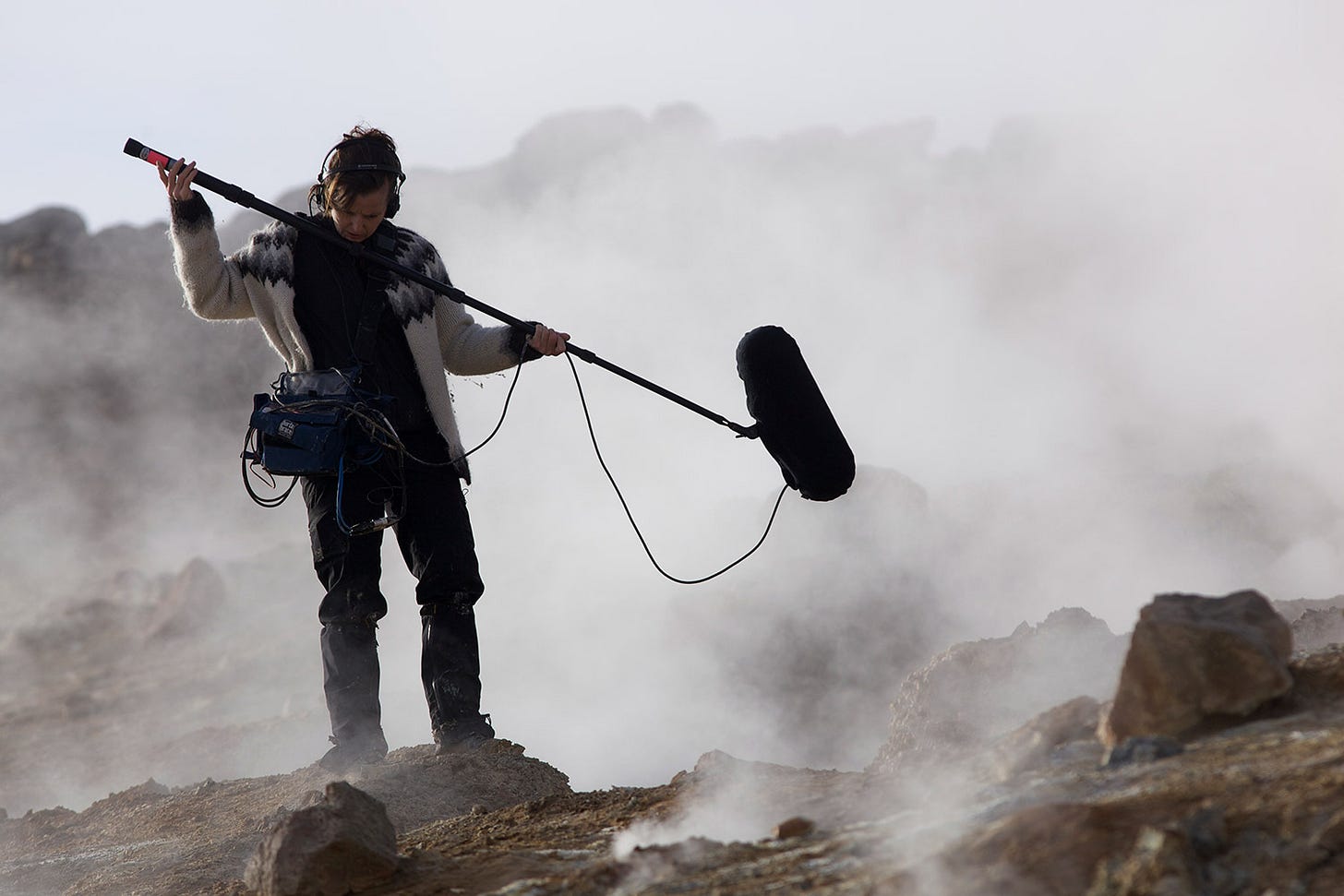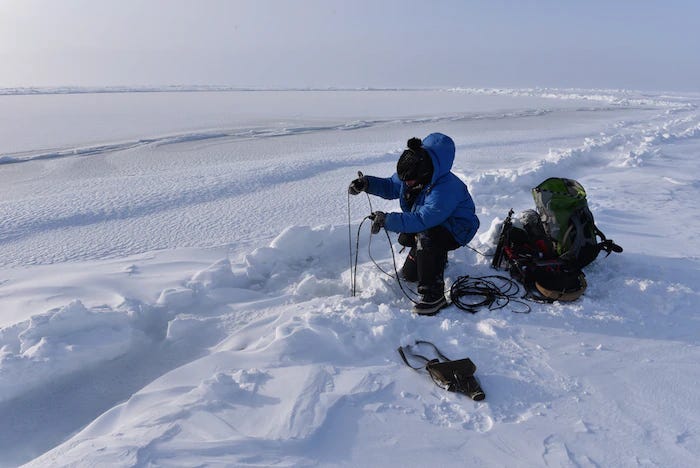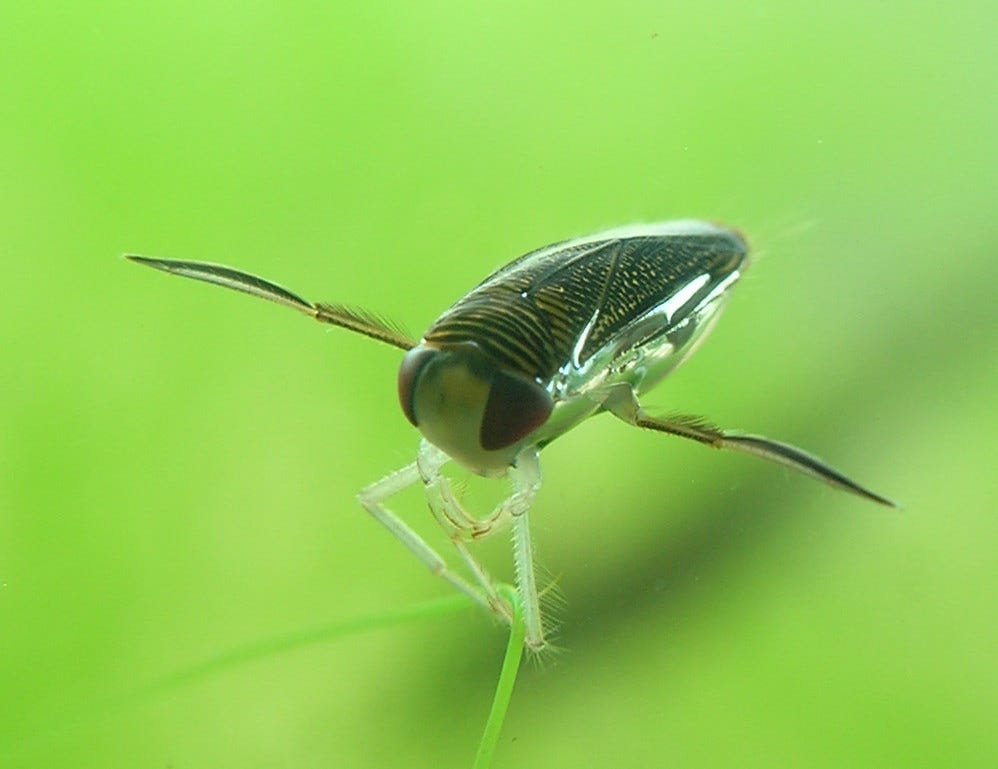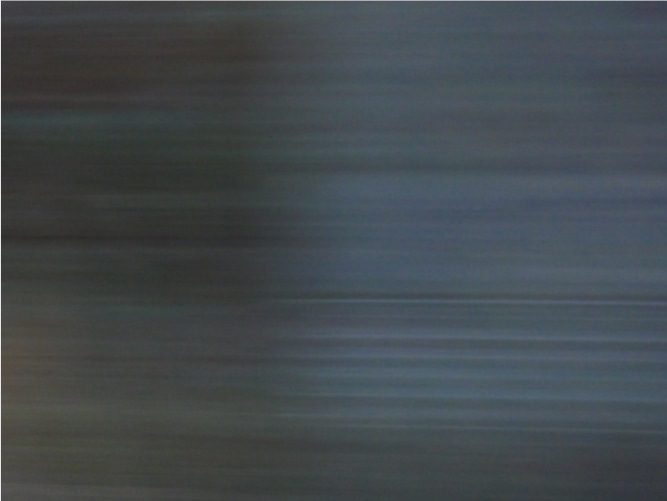so you wanna get into... jana winderen
"I can hear the difference between cod, haddock, herring, pollock, shrimp, snail and catfish."

(photo by finnbogi petursson)
welcome to issue #14 of “tusk is better than rumours,” a newsletter featuring primers and album rankings of experimental and ‘outsider’ musicians. artist primers are published every other monday, and on off-weeks i publish a variety of articles ranging from label and genre primers to interviews to guest writers.
this week is a guide to the work of norwegian field recordist jana winderen, who specializes in recording environments that are difficult to access, mostly underwater. she has traveled to rivers and lakes and seas and oceans from the north pole to the equator with very fancy microphones to record plankton, ice, insects, and animals, documenting immersive (excuse the pun) soundworlds.
sign up to receive the newsletter if you haven’t already! and follow us on twitter @tuskisbetter! and tell a friend! also you can reply to these emails or write to tuskisbetter@gmail.com.
jana winderen has traveled the world recording audio from mostly underwater environments. she organizes the sounds of ice cracking, waves crashing, and creatures chattering into dramatic compositions that bring to life places and animals many of us have never heard before, and would likely never hear without her work. in a series of releases for touch., she has focused on shrimp, zooplankton, a variety of fish, ice melt and surface runoff, and even bats. along with contemporary field recordists chris watson (who she has collaborated with), francisco lopez, gordon hempton, toshiya tsunoda, and others, winderen has helped transform a niche pursuit into a recognized art form.
brief aside regarding the nature of field recording as art
way back in the very first issue i said this regarding field recording:
so i’ve got this whole thing about how field recording is the new punk rock because digital recorders are so cheap and you can edit and mix in audacity and the learning curve is nearly nonexistent and everybody’s aural surroundings are unique, or at least the way they approach recording them is unique, and so in the name of pure horizontal democracy all field recordings are really aesthetically equal and shouldn’t be judged in an hierarchic list like this
as jana winderen’s aural surroundings might seem, well, more unique than yours, i feel i should elaborate. yes winderen travels the world with very expensive equipment, and yes she records sounds that the average person has never heard before, and yes she organizes those sounds into fascinating musical collages that transport you to strange realms of the imagination. but it’s a quirk of the brain that with patience and reframing any sound at all can do something similar. here is brian eno speaking to david toop:
There’s an experiment I did. Since I did it, I started to think it was quite a good exercise that I would recommend to other people. I had taken a DAT recorder to Hyde Park and near Bayswater Road I recorded a period of whatever sound was there: cars going by, dogs, people. I thought nothing much of it and I was sitting at home listening to it on my player. I suddenly had this idea. What about if I take a section of this—a 3-minute section, the length of a single—and I tried to learn it? So that’s what I did […] I printed it on a DAT twenty times or something, so it just kept running over and over. I tried to learn it, exactly as one would a piece of music: oh yeah, that car, accelerates the engine, the revs in the engine go up and then that dog barks, and then you hear that pigeon off to the side there. This was an extremely interesting exercise to do, first of all because I found that you can learn it. Something that is as completely arbitrary and disconnected as that, with sufficient listenings, becomes highly connected. […] It’s like putting oneself in the role of an art perceiver, just deciding, now I’m playing that role. (toop’s Ocean of Sound, serpent’s tail, p. 130)
what eno is describing here is aestheticism, which is not a theory but the practice of constantly reframing your experience of the world in terms of art. mark greif writes about how you should “let a cigarette case you find on the road evoke the whole life of its imagined owner; let your fellow human beings be bearers of plot and motivation as in a work of fiction, possessors of intricate beauty or ugliness as in a painting, objects of uniqueness and fearful sublimity as in a wonder of nature. over time, and with practice, the work of art will become less effective at stimulating these art experiences than your renewed encounters with the world will be” (Against Everything, vintage, p. 88). i would add that you should let the ambient sound around you coalesce into structures of immense complexity as in a classical composition. flaubert famously said “anything becomes interesting if you look at it long enough.” in the same way, anything sounds interesting if you listen long enough. and so, even if your equipment doesn’t cost thousands of dollars and even if you’re stuck inside for the foreseeable future, record the birds outside the window or the annoying clanging sound the radiator makes. it’s not me telling you to, it’s brian eno.
end of brief aside regarding the nature of field recording as art
of course not everyone’s goal is to sit in a chair and listen rapturously to the air conditioning. other folks enjoy, i dunno, novelty and interesting sounds and craftsmanship and such. in which case jana winderen’s work is a good place to get into field recording. like chris watson before her, she has elevated nature recording beyond the documentary soundtrack and into an object of interest in its own right. she has done so by trekking to places outside of normal human traffic and hanging, submerging, squeezing, and thrusting her microphones into spaces that no one has been before, often at very real risk to her person. at base her project is ecological, intended to highlight parts of the ecosystem that are out of sight and out of mind for most of the populace. think of it as a sort of ongoing Planet Earth for your ears. she described her fascination with difficult-to-reach and out-of-the-way places to tokafi:
What I mean by hidden places is those which are not easily available to your ears, like 25 meters down in a crevasse of a glacier, deep into a river, ocean or lake; inside an ants' nest, or between the bark and the wood of a tree; listening to worms, beetles or other insects; or the sound of a caterpillar eating a leaf, the sound of cod or haddock communicating with each other, a sea snail dragging itself along a rock... It can be places where I cannot see the origin of the sound, so it becomes like blind field recording - unless the fish swim up to the surface to look at me, which happened once! […] I am concerned with the invisible topography of the oceans; invisible, but audible; a soundscape which covers 70% of our planet. So much of it is unknown; we know more about the atmosphere and neighboring planets than we do about the oceans themselves. I find this quite extraordinary.
she’s not a trained researcher or biologist; she is an artist whose preferred environment is the museum or the stage. but through her rather daring recordings of these environments, many of which are threatened by global warming, she has worked with scientists and done more than most to translate their message to a broader audience. she just doesn’t do it in words because nature can speak much more dramatically for itself.
i guess i’ll stick to my guns and continue to insist that “all field recordings are really aesthetically equal and shouldn’t be judged in an hierarchic list like this” so i’ve presented winderen’s work below in reverse chronological order. work your way backwards through her discography or, if one grabs your attention, jump right in at any point. listen enough and like eno says, you can learn it. dates refer to original releases and not to recordings, installations, or performances.

(photo by sergey panteleev)
Pasvikdalen (2019)
in 2014 winderen went on a research trip to kirkenes, norway and nikel and zapolyarny, russia. on the trip, she made recordings both above and below the arctic ice and named the resulting piece after the valley between norway and russia. i’m not one of those folks who gets the whole asmr thing but this comes close to working even on me. chatterings and squeakings and clicks and creaks take up the upper register while big washes of bassy drone (i think maybe from boat engines?) shifts and glides underneath. now is probably the time to mention that aside from all the arctic exploring and whatnot wenderen has impressive compositional skills, and that each of these pieces is carefully designed with a larger structure in mind. no sound overstays its welcome, and extreme sounds in either direction are counterpoised against one another in this and all of her work.
Spring Bloom in the Marginal Ice Zone (2018)
all of this work is political, of course, in that it documents sounds of areas and species that most people have not encountered. these areas and species are also some of the most endangered by climate change, so any increased awareness of them is a net positive—you can’t advocate for what you’re unaware of. Spring Bloom in the Marginal Ice Zone, though, takes this implicit mission and brings it into the foreground. it begins with a 5-minute mini-lecture by carlos duarte, professor of marine science at king abdullah university. he explains that there is a two- to three-week period after the arctic winter during which an even called the “algal bloom” takes place. in this period, algae in the arctic ocean begins to photosynthesize and grow, setting up the ecosystem for the next year. this mass of algae is a) the biggest carbon dioxide sink in the world and b) the basis for a whole stretch of links in the food chain. it’s already too late to prevent the arctic from losing its ice, says duarte. now the goal is contain the effects of the process and to learn about the algal bloom’s role in depleting carbon and outputting oxygen. the marginal ice zone is the area of contention—this is the ever-changing (and ever-shrinking) border between ice and sea. wenderen records the ice, the water, and the animals that inhabit this zone. she records bearded seals, humpback whales, orcas, and other animals in the barents sea around spitsbergen, norway. all of these animals rely on the spring bloom of the marginal ice zone, and wenderen’s recordings of them perform the crucial task of documenting their fragile existence.

(corixa, or lesser water boatman; photo by piet spaans via wikipedia)
The Listener (2016)
if you listen intently to the insects in a river, you can determine the health of that river. that is, if you have a lot of training in… river… health. what happens is that certain insects can’t survive certain amounts of certain types of pollution, so by carefully listening for those insects you can tell what pollutants are in the water in what amounts. that fellow up there is a lesser water boatman, and he lives under water all his life. he features prominently on The Listener (or at least his friends do). this recording was made as part of a three-year study to determine the health of the river orne in normandy, france. it sounds healthy to me, though i am not a smart guy and don’t know much about rivers. but there are plenty of insects to be heard here, along with a few frogs. this is perhaps the least dramatic of winderen’s releases, but that’s not necessarily a bad thing. it’s a soothing listen, reminiscent of summers spent in the outdoors.
The Wanderer (2015)
phytoplankton feed zooplankton, which in turn feed fish and marine mammals. so really the whole dang oceanic ecosystem relies on those lil phytoplankton. they wander around the world’s oceans, and so winderen wandered around recording the different places they exist, from the north pole to the equator. it’s impossible to tell where these sounds come from—the crunching and crackling of little insects are familiar from winderen’s other work, sure, but the ghostly murmurings that enter in the piece’s last third are another thing altogether. winderen was a 2015 finalist for norway’s lorck schive art prize, said to be comparable to the uk’s turner prize. this piece was recorded for that prize, to be played at the trondheim kunstmuseum.
Evaporation (2014)
winderen also creates sound installations which, while i haven’t been to any, seem like the best way to take in her work. Evaporation is a collection of three of these: the title track, “sub pelagic voices,” and “north atlantic drift.” the focus here is obviously on water, but unlike the cliched raindrops and babbling brooks found on other field recordings, these tracks present enveloping panoramas of otherworldly sound, from ominous hummms to creaking and croaking ice.
Cloitre (with Thomas Köner)(2014)
this is a live collaboration with the german multimedia artist thomas köner, recorded in the cloister of the évreux cathedral in normandy, france. it features all of winderen’s bird calls, ice crackles, and water splashes, while köner provides almost frightening dark ambient drones. but the real star here is the reverb of the cathedral itself, which gives the proceedings a massive sense of scale.

(photo by jon wozencroft, head of touch.)
Out of Range (2014)
results vary, but humans can hear in the range of 20 to 20,000 hertz (i just very unscientifically tested myself using this video with headphones and got 27 to ~15,000 hz—that’s probably bad?). anyhow there are animals that can hear what we call “ultrasound,” which is the range above 20 khz. bats can hear way way up above us, to around 115,000 hertz (depending on the species of course). on Out of Range, winderen traveled to central park, nyc; regents park, london; kaliningrad, russia; madeira, portugal; and across the nordic countries to record dolphins, bats, insects, and other animals that make sounds out of human hearing. she then time-stretched the results to bring them within human hearing range and organized them into a beguiling and mysterious 40-minute track. the trick is that she also included some recordings that ARE normally audible, so you can never be sure if what you’re hearing is your standard cricket or some insane bat language. jon wozencroft supplied a set of photographs to accompany this release, saying that they “mirror ‘the audible range’ through a contrast between gateways, portals and sight lines, set against situations where the camera eye cannot make sense of the optical event it is confronted with.”
Débris (2012)
this is perhaps a more minor work, pairing together two relatively short pieces from early in winderen’s career. “scuttling around in the shadows” and “drying out in the sun,” the album’s two tracks, pack a more dynamic range of sounds in their abbreviated run times than many of her longer pieces, however. this is a good option for a quick overview of the (extensive) boundaries of winderen’s soundworld, or if you want to put some winderen on a mixtape but don’t have 40 minutes of free space.
Energy Field (2010)
this recording was made in the ice fields of norway and greenland in glacier crevasses and fjords. it begins simply enough with a chorus of dogs barking, but soon turns terrifying as rumblings, drones, and echoes from cavernous ice worlds take center stage. during the last track, the aptly named “sense of latent power,” a cathedralic immensity of sound emerges seemingly from the ether, permeating the space in a way that would signal to a movie audience that the protagonist has entered the villain’s underground lair. if i heard these sounds occurring naturally, i would simply leave the area. but luckily winderen braved whatever icy ghouls that produce them to share with us in our nice quarantined comfort. i’m only half-kidding; she recounts that when she made these recordings “i was sitting far too close to the ice fjord, [but] not realizing that. afterwards, on my way back, i saw a sign saying ‘do not enter, extreme danger to life.’”
The Noisiest Guys on the Planet (2009)
i’ve never seen a press release with more marine-biological information. check this out, from forced exposure’s mail order page:
The decapods or Decapoda ("ten-footed") are an order of crustaceans within the class Malacostraca, including many familiar groups, such as crayfish, crabs, lobsters, prawns and shrimp. Most decapods are scavengers. As their name implies, all decapods have ten legs; these are the last five of the eight pairs of thoracic appendages characteristic of crustaceans. The front three pairs function as mouthparts and are generally referred to as maxillipeds, the remainder being pereiopods. In many decapods, however, one pair of legs has enlarged pincers; the claws are called chelae, so those legs may be called chelipeds.
anyway, turns out that crabs and lobsters and such make quite a lot of noise. if you didn’t know any better you’d think this was a recording of raindrops falling on a giant bonfire, or maybe little fires falling into a swimming pool… anyhow, the highlight here for me is actually the background tones which come from, again, maybe boat engines? a gentle repetitive hum pervades this recording that is actually in time, and anchors (boat pun) the whole piece for its duration.
alright that’s it for this week, except i just wanted to add a
tiny quarantine quorner
because i found out that the great fugazi documentary Instrument is on youtube. watch it here:
you can help support the newsletter for the price of a coffee. all donations go toward paying guest writers (check back next week for the first one!) and offsetting the costs of production (bandcamp downloads, food, stimulants)


